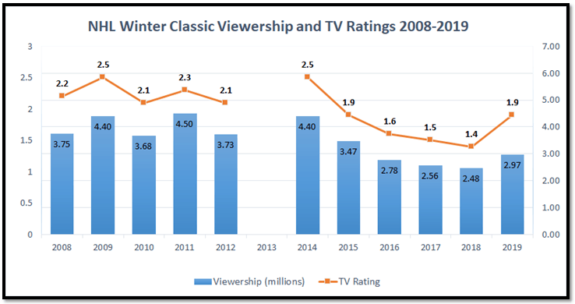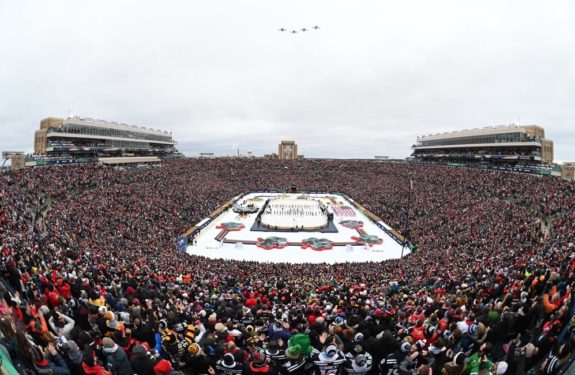The latest version of the NHL Winter Classic featuring the Chicago Blackhawks and Boston Bruins was played this week on Jan. 1 in front of 76,126 fans at Notre Dame Stadium, the home of the University of Notre Dame Fighting Irish football team. The attendance number was the second-largest crowd for the annual event since its inaugural game in 2008 when the Pittsburgh Penguins played the Buffalo Sabres in front of 71,217 fans at Ralph Wilson Stadium in Orchard Park, New York.
While the stadium attendance numbers for this event have been impressive over its 11-year history, the outdoor games have been skating on thin ice since the game in 2014 between the Toronto Maple Leafs and the Detroit Red Wings at Michigan Stadium in Ann Arbor, Michigan. That game was played in front of a record hockey crowd of 105,491 fans. Since then, up to and including the game last year, the TV ratings have dropped from 2.5 to 1.4, a decrease of 44 percent, while the viewership number fell 43.6 percent from 4.40 million to 2.48 million.

That was not good news for NBC, who has the broadcast rights to the game until the 2020-21 season, and their sponsorship and advertising partners that depend on viewers watching the game on NBC to showcase their products and services. On the other hand, the television ratings for the Winter Classic continue to exceed those recorded for the Stanley Cup Playoffs in the US market.
The story is different in Canada where Hockey Night in Canada regular-season telecasts attract more viewers than the Winter Classic. The theory for this trend is that Canadian teams have been featured in the event only twice; in 2014 with the Maple Leafs and in 2016 with the Montreal Canadiens. Additionally, a Canadian city has never hosted the Winter Classic.
The 2019 Winter Classic
Fast-forward to 2019. This year’s Winter Classic posted viewership numbers that rose 19.8 percent over last year. According to National Data from Nielsen and digital data from Adobe Analytics, the game generated a Total Audience Delivery (TAD) of nearly three million viewers which included viewers on the NBC Television Network, NBC Sports.com and NBC Sports app online viewers. The TV-only ratings increased from 1.4 last year to 1.9, an impressive increase of 35.7 percent, and the highest score since 2015.

The main reason for the recovery of the fan engagement numbers appears to be the result of the explosive growth of wireless portable device usage and social media engagement. This year’s Winter Classic set records for all primary digital metrics, including uniques (75,963), total minutes (4.7 million) and Average Minute Audience (22,454 viewers), with those figures being up 38, 51, and 45 percent, respectively, versus the game in 2018.
Back to The Future
Where does the future lie for the Winter Classic? The NHL strategy of developing innovative sports events has served them well and attracted recognition in the sports entertainment industry. In 2014, the Sports Business Daily and the Sports Business Journal awarded the Winter Classic the “Sports Event of the Year,” the second time the event received that distinction. Outdoor games like the Heritage Classic, Stadium Series and Winter Classic continue to attract large crowds and remain appealing to dedicated sponsors like Bridgestone and Tim Hortons.
The focus of these games to take the fan back to the grassroots of the game, when it was played on ponds, appears to continue to appeal to both hardcore hockey fans and occasional fans in some non-traditional hockey markets. The NHL sees value in the outdoor games to promote the sport of hockey in the host markets, to recognize local community organizations and to engage the alumni of the two competing teams by participating in the events attached to what have become three-day hockey festivals.
The continued development of technology will play a vital role in the future success of sports events like the Winter Classic. The NHL and their production and broadcast partners will continue to face the challenge of making the outdoor event exciting to both the TV and online viewer.
Improving the fan entertainment experience in a large venue will require more innovative technology and investment to fulfill ever-demanding fan expectations when viewing the game live, and while engaging with family and friends on social media during the game. Like all professional sports events, a commitment to technology innovation and investment will dictate the future appeal of the Winter Classic and its level of profitability to the NHL and its partners.